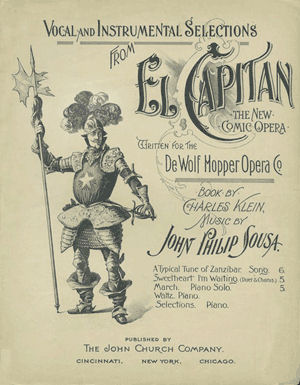This Sousa wind band series continues to grow. One has to admit
that Sousa’s prolific output of stirring tunes is justly acknowledged
by Naxos. This inventive composer has found many textural corners
to turn in a march, even if some of his musical devices have become
predictable.
The most interesting track for many will be the long forgotten
El Capitan: in this compilation there is a generous selection
covering the numbers from this Broadway show. Many forget that
Sousa was an enthusiastic composer for the stage, with nine operettas
to his name, written between the 1880s and early 1900s. Of them
El Capitan is the most notable. A
Bride Elect selection
was included in Volume 4 of this series, and marches from both
operettas appeared in Volume 7.
Some of the titles provide little indication of the music to follow.
In
The Northern Pines, the only connection happens to be
the location of a national music camp in Michigan. Likewise, the
Crusader March having associations with the Knights Templar,
carries no aural link yet it is a good piece with an excellent
sense of flow, punctuated by fanfare sections.
Sousa is always sparkling in style. His fun and humour is perhaps
most apparent in his use of novel decoration for the comic cuts
introduced in track 7,
On the Campus, the only track to
include a chorus. Up to now, the most famous of Sousa marches
that had been missing from the previous volumes in this series,
The Washington Post, now makes an appearance as the last
track. This sturdy piece echoed round many a circus ring in Britain
and on the Continent as well as America before being flung into
popularity by the BBC’s
Monty Python programme. In contrast
the delicately phrased waltz style,
O Warrior Grim is a
tranquil piece with carefully balanced cornet solo (by Martin
Hinton).
Keith Brion needs to be congratulated for the most successful
ambience. Then there’s precision playing by the Royal Artillery
Band and a recording nicely balanced by Mike Purton. In military
music there is often a tendency for the percussion to mask the
more delicate phrases of woodwind, yet here much sensitivity is
shown to provide us with wide dynamics and colour.
The notes, in English only, are adequate yet disappointing; all
the more so when the jewel case is filled with a lavish catalogue
on heavy-weight paper of Naxos American Classics. This catalogue
is likely to be discarded. More information about Sousa’s background
and influences would have been welcomed, considering his enormous
output of some two hundred pieces.
Raymond J Walker


